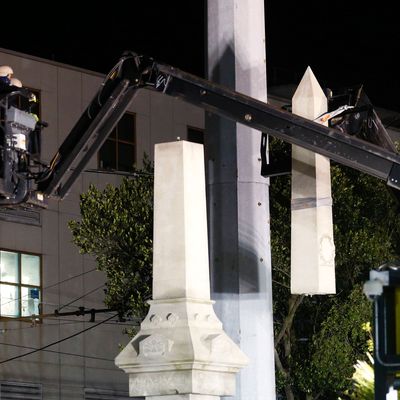
The demolition of New Orleans’s monument to the members of the Crescent City White League who died in the Battle of Liberty Place is largely being covered as just another incident in the long-running effort to remove Confederate memorials from prominent official venues, and place them in museums where they denote tragic history, rather than defiant current policy. That’s understandable: The Liberty Place obelisk is the first of four New Orleans monuments the City Council condemned to removal in 2015; the others are of Confederate leaders Robert E. Lee, Jefferson Davis, and P.G.T. Beauregard. It was also an obvious news angle that demolition of the Liberty Place monument occurred on the day formerly recognized in much of the South (and still recognized in Alabama and Mississippi) as Confederate Memorial Day.
But it is important to understand in this brief moment of publicity that the event commemorated by the now-defunct monument wasn’t anything that happened during the Civil War. The Battle of Liberty Place was a major incident in the white southern terrorist resistance to postwar Reconstruction. The battle occurred in 1874, and although it was a bit of a standoff from a military point of view, its violence fed the exhaustion of northern (and Republican) willingness to defend the gains of the Civil War, leading to the abandonment of Reconstruction a few years later, followed by white supremacist rule and ultimately Jim Crow.
The combatants initially honored by the Liberty Place monument (a marker was added in 1974 that claimed it commemorated the fallen on both sides of the battle) were slain members of the Crescent City White League, an avowedly racist organization seeking to overturn a Republican state government elected with allegedly “corrupt” African-American votes. Police and state-militia forces — eventually relieved by federal troops — fought them in the streets of New Orleans. As Stephen Budiansky explains in his definitive account of white anti-Reconstruction terrorism in the South, The Bloody Shirt, the battle illustrated the limits of federal military power when resisted by armed white Southerners. It also showed the tragic futility of President U.S. Grant’s courageous efforts to vindicate the voting rights of ex-slaves, at a time when southern white hostility and northern white indifference made it a cause as lost as the Confederacy itself.
There were all sorts of ancillary effects of the Battle of Liberty Place. For one thing, the police and militia forces fighting the White League were at least initially commanded by the great Confederate General James Longstreet, revered during the Civil War as Robert E. Lee’s strong right arm in commanding the Army of Northern Virginia. Longstreet became a Republican after the war and settled in New Orleans; his “disgrace” in ex-Confederate eyes was consummated by the shedding of white blood at Liberty Place. As Budiansky explained in his book, the cult of Stonewall Jackson owed a lot to the politically driven need to disparage Longstreet’s contributions to Lee and the Confederate military.
It is no accident that the Liberty Place monument was authorized in 1891, during the period when Louisiana was busy disenfranchising African-American voters and institutionalizing segregation. It is not a monument to the Confederacy, but rather to the neo-Confederacy, the entirely illegitimate ideological movement that, unlike the Confederate States of America, actually succeeded in its principal aims for many decades. Precisely because it prevailed for so long, so (relatively) recently, its monuments need pulling down more urgently than those of the secessionist cause. And so yesterday’s accomplishment by New Orleans, although long overdue, is one in which all Americans can share with real pride.






























